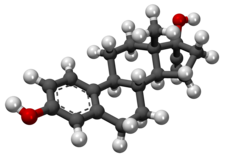







The images only for reference
Ethinylestradiol (EE) is an estrogen medication which is used widely in birth control pills in combination with progestins.[9] It is also occasionally used as a component of menopausal hormone therapy for the treatment of menopausal symptoms in combination with progestins.[9] In the past, EE was widely used alone for various indications such as the treatment of gynecological disorders and prostate cancer, but this is no longer the case. It is usually taken by mouth.[9]
The general side effects of EE include breast tenderness and enlargement, headache, fluid retention, and nausea among others.In men, EE can additionally cause breast development, feminization in general, hypogonadism, and sexual dysfunction. Rare but serious side effects include blood clots, liver damage, and cancer of the uterus.
EE is an estrogen, or an agonist of the estrogen receptors.It is a synthetic derivative of the natural estrogen estradiol, and differs from estradiol in various ways.Compared to estradiol, EE has greatly improved bioavailability when taken by mouth, is more resistant to metabolism, and shows relatively increased effects in certain parts of the body like the liver and uterus.These differences make EE more favorable for use in birth control pills than estradiol, though also result in an increased risk of blood clots and certain other rare adverse effects.
EE was developed in the 1930s and was introduced for medical use in 1943.The drug started being used in birth control pills in the 1960s.Today, EE is found in almost all combined forms of birth control pills and is nearly the exclusive estrogen used for this purpose, making it one of if not the most widely used estrogens.
 | |
 | |
| Clinical data | |
|---|---|
| Pronunciation | /??θ?n?l?i?str??da?.?l/ |
| Trade names | Numerous |
| Synonyms | 17α-Ethynylestradiol; 17α-Ethynylestra-1,3,5(10)-triene-3,17β-diol; NSC-10973 |
| Pharmacokinetic data | |
|---|---|
| Bioavailability | 38–48%[3][4] |
| Protein binding | 97–98% (to albumin;[5] is not bound to SHBG)[6] |
| Metabolism | Liver (primarily CYP3A4)[2] |
| Biological half-life | 7–36 hours[7][3][2][8] |
| Excretion | Feces: 62%[7] Urine: 38%[7] |
| Identifiers | |
| CAS Number | |
| PubChem CID | |
| IUPHAR/BPS | |
| DrugBank | |
| ChemSpider | |
| UNII | |
| KEGG | |
| ChEBI | |
| ChEMBL | |
| ECHA InfoCard | 100.000.311 |
| Chemical and physical data | |
| Formula | C20H24O2 |
| Molar mass | 296.403 g/mol |
没有评论:
发表评论